Comprehensive Report: Human Capital and Leadership Strategies at Tesco
VerifiedAdded on 2020/11/23
|18
|5222
|360
Report
AI Summary
This report provides an in-depth analysis of human capital and leadership within Tesco, a major UK retailer. It begins by examining two key models for managing human resources: the Harvard and Michigan models, detailing their components and applications within the organization. The report then explores Tesco's recruitment and selection processes, highlighting both internal and external sources, as well as strategic human resource initiatives, including the adoption of HR technology and the importance of data security and employee development. Furthermore, the report delves into Human Resource Development (HRD) approaches used by Tesco, such as the integrative framework and human capital appraisal. It also examines classical theories of motivation and proposes a hybrid theory to combine meaningful characteristics. Finally, the report identifies characteristics of effective leaders, supported by a model derived from the analysis. The conclusion summarizes the key findings and emphasizes the importance of effective human capital management and leadership for Tesco's success.
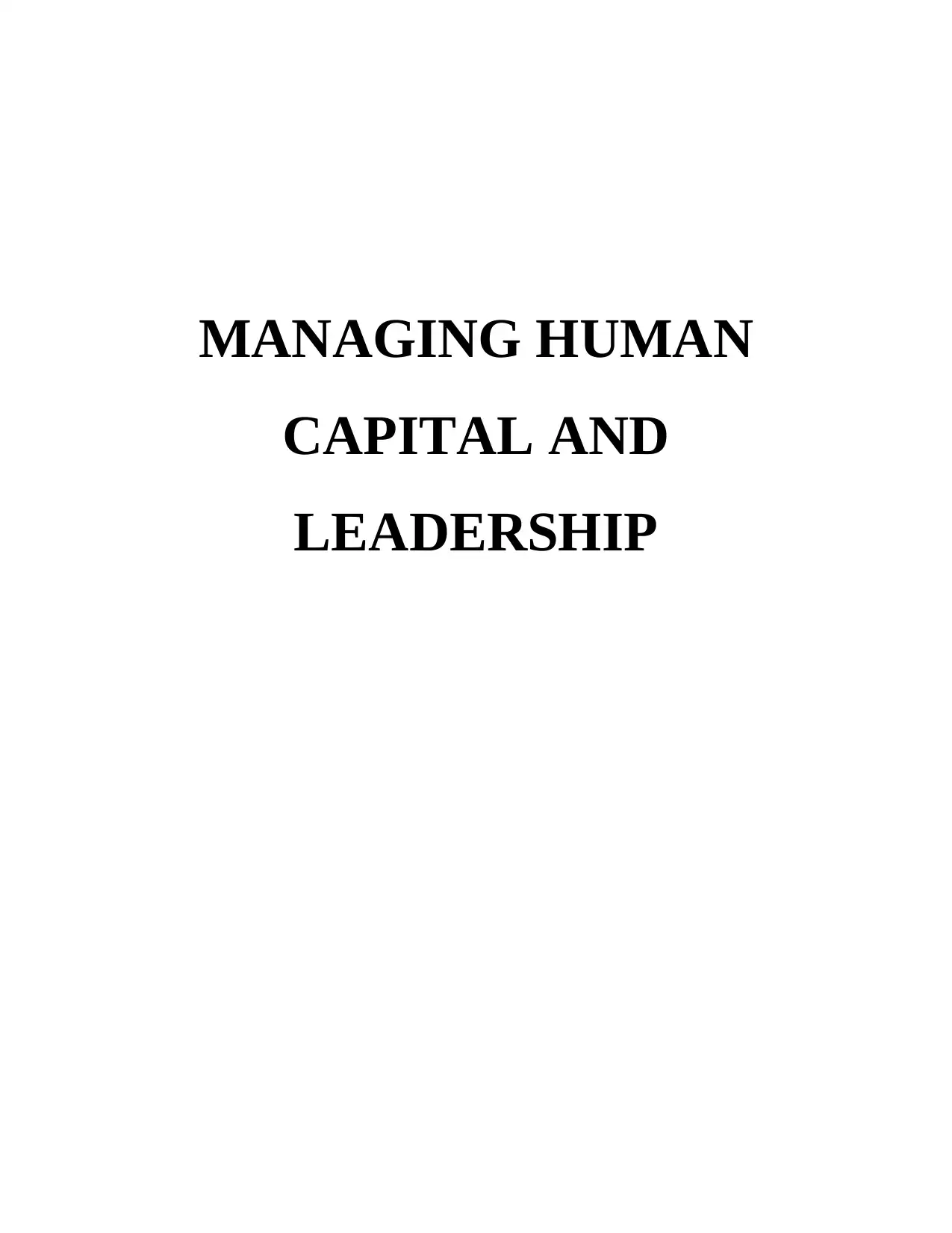
MANAGING HUMAN
CAPITAL AND
LEADERSHIP
CAPITAL AND
LEADERSHIP
Paraphrase This Document
Need a fresh take? Get an instant paraphrase of this document with our AI Paraphraser
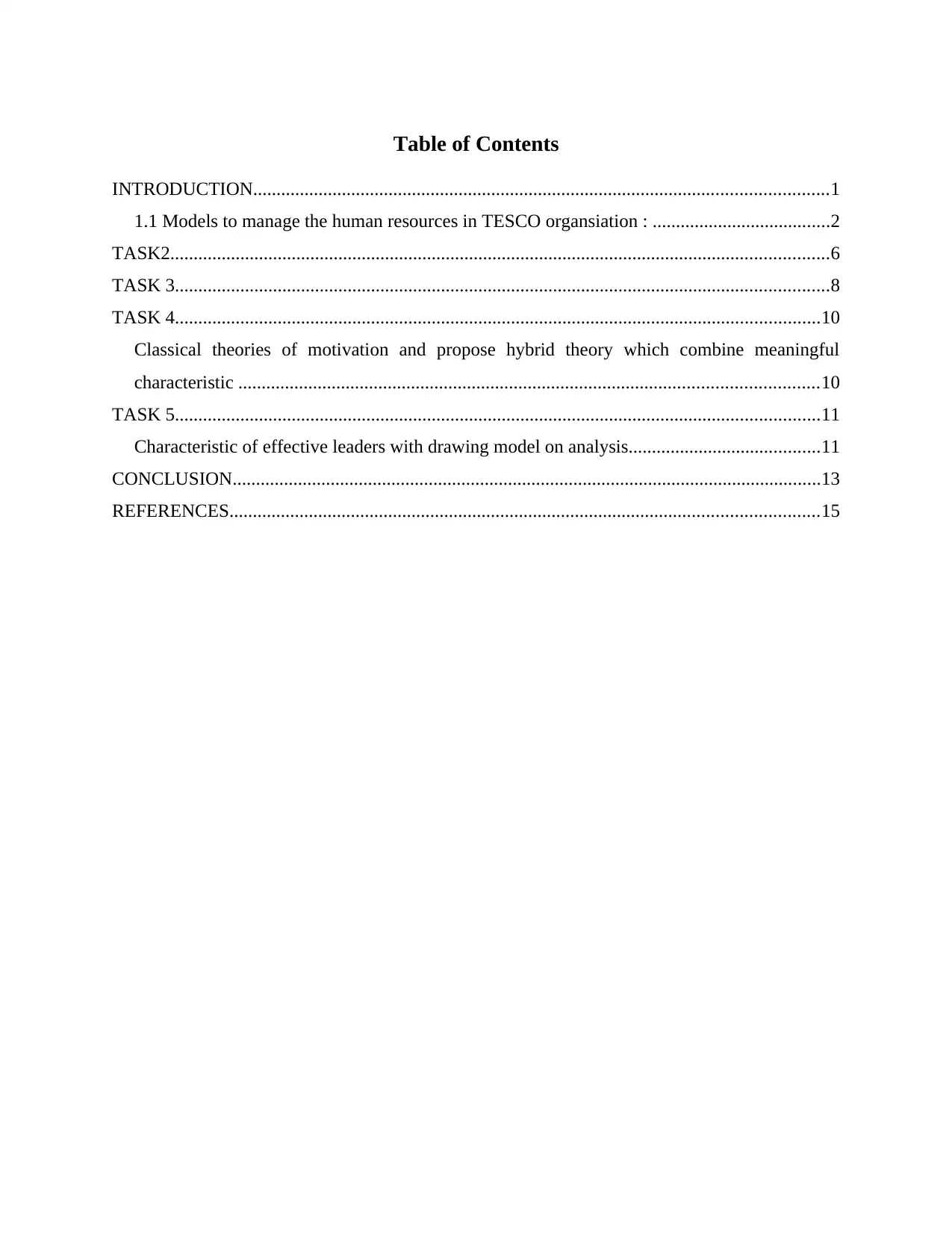
Table of Contents
INTRODUCTION...........................................................................................................................1
1.1 Models to manage the human resources in TESCO organsiation : ......................................2
TASK2.............................................................................................................................................6
TASK 3............................................................................................................................................8
TASK 4..........................................................................................................................................10
Classical theories of motivation and propose hybrid theory which combine meaningful
characteristic ............................................................................................................................10
TASK 5..........................................................................................................................................11
Characteristic of effective leaders with drawing model on analysis.........................................11
CONCLUSION..............................................................................................................................13
REFERENCES..............................................................................................................................15
INTRODUCTION...........................................................................................................................1
1.1 Models to manage the human resources in TESCO organsiation : ......................................2
TASK2.............................................................................................................................................6
TASK 3............................................................................................................................................8
TASK 4..........................................................................................................................................10
Classical theories of motivation and propose hybrid theory which combine meaningful
characteristic ............................................................................................................................10
TASK 5..........................................................................................................................................11
Characteristic of effective leaders with drawing model on analysis.........................................11
CONCLUSION..............................................................................................................................13
REFERENCES..............................................................................................................................15

⊘ This is a preview!⊘
Do you want full access?
Subscribe today to unlock all pages.

Trusted by 1+ million students worldwide
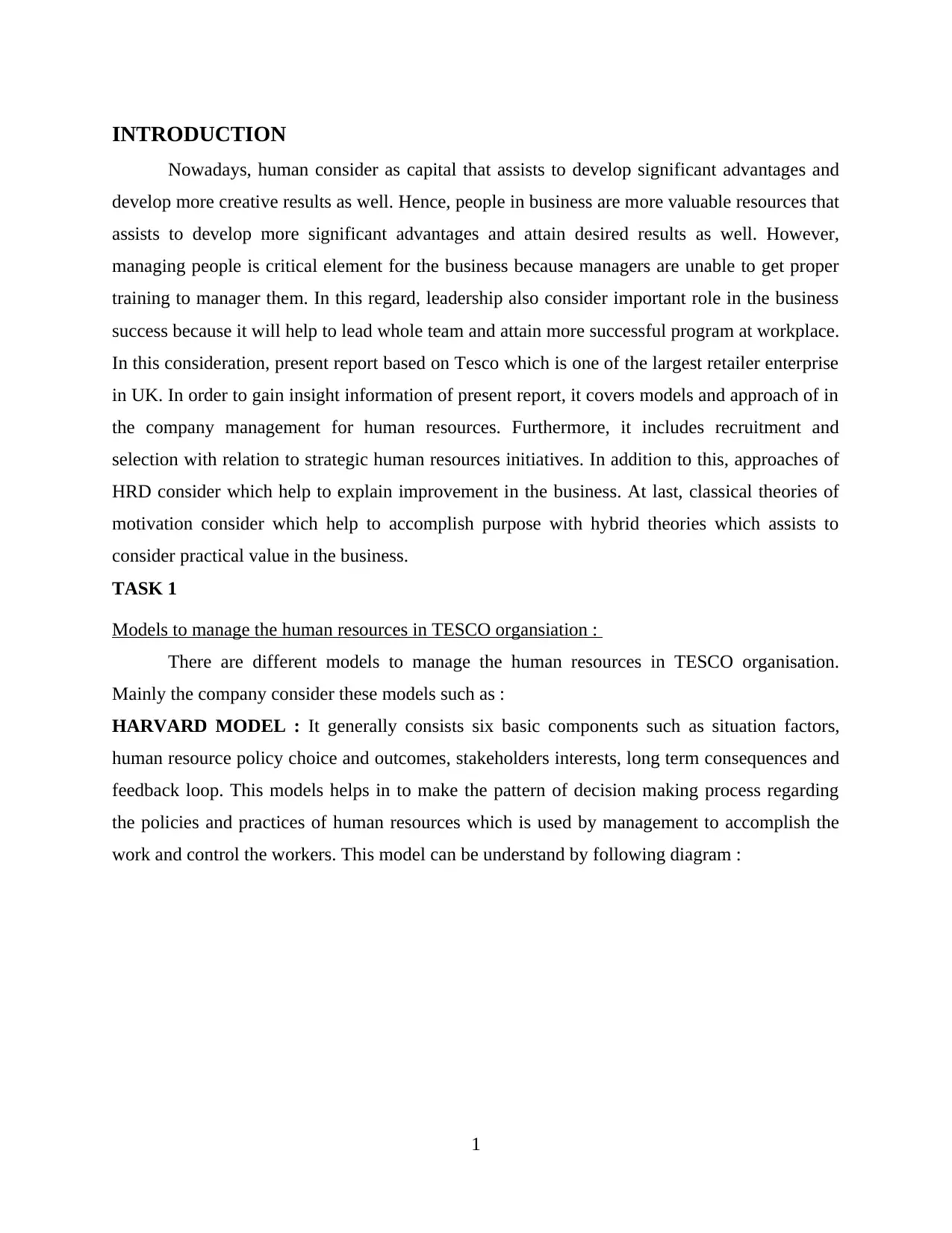
INTRODUCTION
Nowadays, human consider as capital that assists to develop significant advantages and
develop more creative results as well. Hence, people in business are more valuable resources that
assists to develop more significant advantages and attain desired results as well. However,
managing people is critical element for the business because managers are unable to get proper
training to manager them. In this regard, leadership also consider important role in the business
success because it will help to lead whole team and attain more successful program at workplace.
In this consideration, present report based on Tesco which is one of the largest retailer enterprise
in UK. In order to gain insight information of present report, it covers models and approach of in
the company management for human resources. Furthermore, it includes recruitment and
selection with relation to strategic human resources initiatives. In addition to this, approaches of
HRD consider which help to explain improvement in the business. At last, classical theories of
motivation consider which help to accomplish purpose with hybrid theories which assists to
consider practical value in the business.
TASK 1
Models to manage the human resources in TESCO organsiation :
There are different models to manage the human resources in TESCO organisation.
Mainly the company consider these models such as :
HARVARD MODEL : It generally consists six basic components such as situation factors,
human resource policy choice and outcomes, stakeholders interests, long term consequences and
feedback loop. This models helps in to make the pattern of decision making process regarding
the policies and practices of human resources which is used by management to accomplish the
work and control the workers. This model can be understand by following diagram :
1
Nowadays, human consider as capital that assists to develop significant advantages and
develop more creative results as well. Hence, people in business are more valuable resources that
assists to develop more significant advantages and attain desired results as well. However,
managing people is critical element for the business because managers are unable to get proper
training to manager them. In this regard, leadership also consider important role in the business
success because it will help to lead whole team and attain more successful program at workplace.
In this consideration, present report based on Tesco which is one of the largest retailer enterprise
in UK. In order to gain insight information of present report, it covers models and approach of in
the company management for human resources. Furthermore, it includes recruitment and
selection with relation to strategic human resources initiatives. In addition to this, approaches of
HRD consider which help to explain improvement in the business. At last, classical theories of
motivation consider which help to accomplish purpose with hybrid theories which assists to
consider practical value in the business.
TASK 1
Models to manage the human resources in TESCO organsiation :
There are different models to manage the human resources in TESCO organisation.
Mainly the company consider these models such as :
HARVARD MODEL : It generally consists six basic components such as situation factors,
human resource policy choice and outcomes, stakeholders interests, long term consequences and
feedback loop. This models helps in to make the pattern of decision making process regarding
the policies and practices of human resources which is used by management to accomplish the
work and control the workers. This model can be understand by following diagram :
1
Paraphrase This Document
Need a fresh take? Get an instant paraphrase of this document with our AI Paraphraser
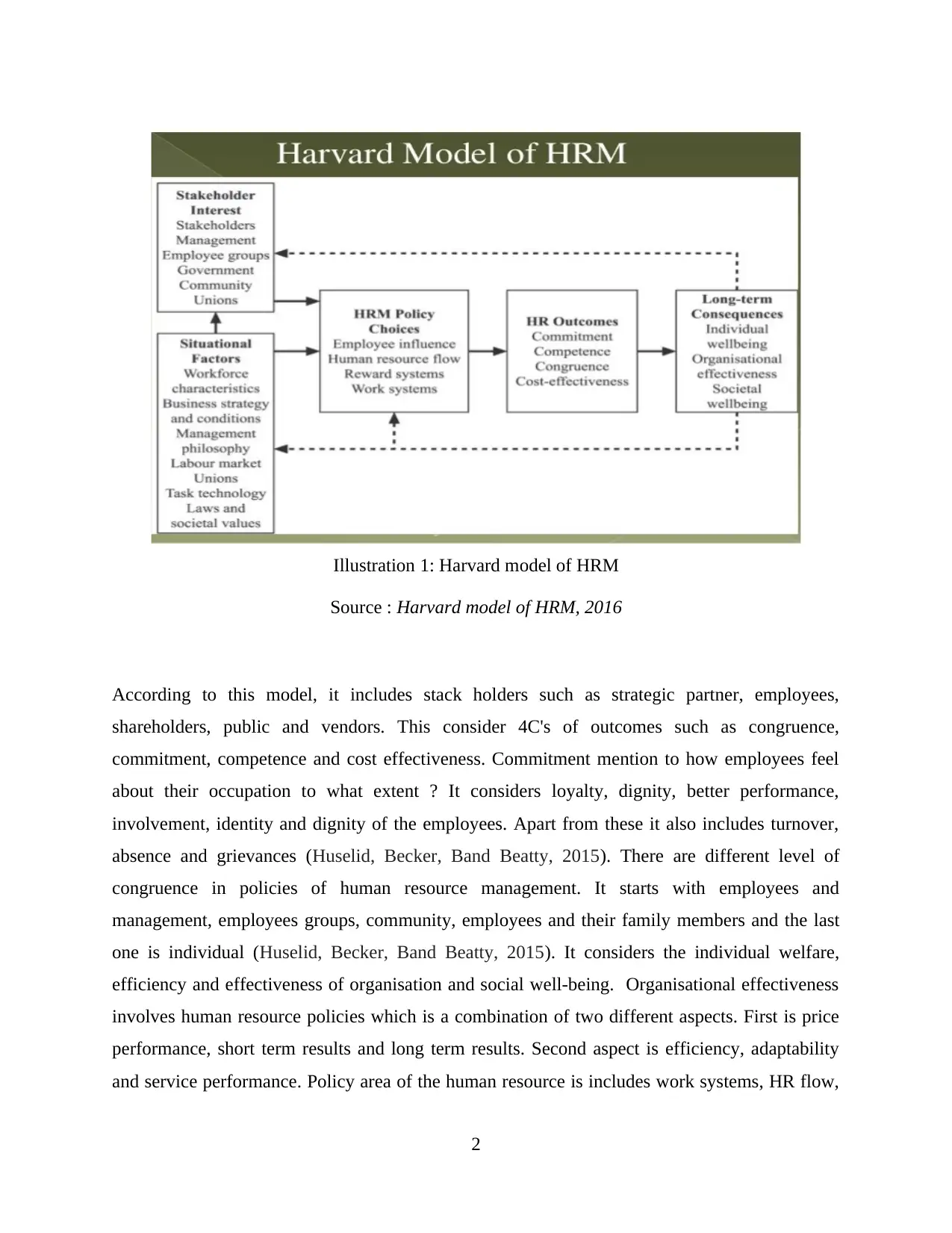
According to this model, it includes stack holders such as strategic partner, employees,
shareholders, public and vendors. This consider 4C's of outcomes such as congruence,
commitment, competence and cost effectiveness. Commitment mention to how employees feel
about their occupation to what extent ? It considers loyalty, dignity, better performance,
involvement, identity and dignity of the employees. Apart from these it also includes turnover,
absence and grievances (Huselid, Becker, Band Beatty, 2015). There are different level of
congruence in policies of human resource management. It starts with employees and
management, employees groups, community, employees and their family members and the last
one is individual (Huselid, Becker, Band Beatty, 2015). It considers the individual welfare,
efficiency and effectiveness of organisation and social well-being. Organisational effectiveness
involves human resource policies which is a combination of two different aspects. First is price
performance, short term results and long term results. Second aspect is efficiency, adaptability
and service performance. Policy area of the human resource is includes work systems, HR flow,
2
Illustration 1: Harvard model of HRM
Source : Harvard model of HRM, 2016
shareholders, public and vendors. This consider 4C's of outcomes such as congruence,
commitment, competence and cost effectiveness. Commitment mention to how employees feel
about their occupation to what extent ? It considers loyalty, dignity, better performance,
involvement, identity and dignity of the employees. Apart from these it also includes turnover,
absence and grievances (Huselid, Becker, Band Beatty, 2015). There are different level of
congruence in policies of human resource management. It starts with employees and
management, employees groups, community, employees and their family members and the last
one is individual (Huselid, Becker, Band Beatty, 2015). It considers the individual welfare,
efficiency and effectiveness of organisation and social well-being. Organisational effectiveness
involves human resource policies which is a combination of two different aspects. First is price
performance, short term results and long term results. Second aspect is efficiency, adaptability
and service performance. Policy area of the human resource is includes work systems, HR flow,
2
Illustration 1: Harvard model of HRM
Source : Harvard model of HRM, 2016
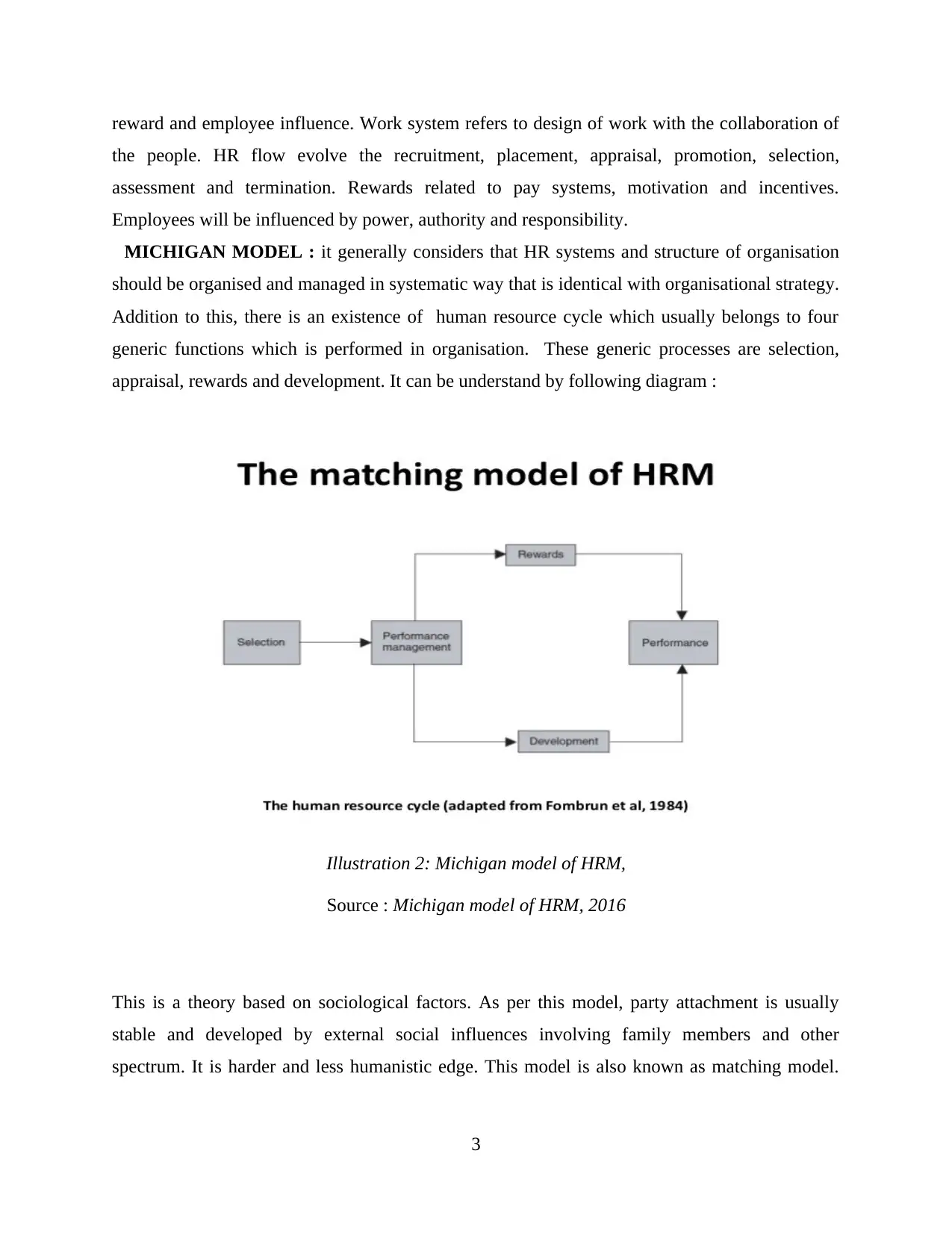
reward and employee influence. Work system refers to design of work with the collaboration of
the people. HR flow evolve the recruitment, placement, appraisal, promotion, selection,
assessment and termination. Rewards related to pay systems, motivation and incentives.
Employees will be influenced by power, authority and responsibility.
MICHIGAN MODEL : it generally considers that HR systems and structure of organisation
should be organised and managed in systematic way that is identical with organisational strategy.
Addition to this, there is an existence of human resource cycle which usually belongs to four
generic functions which is performed in organisation. These generic processes are selection,
appraisal, rewards and development. It can be understand by following diagram :
This is a theory based on sociological factors. As per this model, party attachment is usually
stable and developed by external social influences involving family members and other
spectrum. It is harder and less humanistic edge. This model is also known as matching model.
3
Illustration 2: Michigan model of HRM,
Source : Michigan model of HRM, 2016
the people. HR flow evolve the recruitment, placement, appraisal, promotion, selection,
assessment and termination. Rewards related to pay systems, motivation and incentives.
Employees will be influenced by power, authority and responsibility.
MICHIGAN MODEL : it generally considers that HR systems and structure of organisation
should be organised and managed in systematic way that is identical with organisational strategy.
Addition to this, there is an existence of human resource cycle which usually belongs to four
generic functions which is performed in organisation. These generic processes are selection,
appraisal, rewards and development. It can be understand by following diagram :
This is a theory based on sociological factors. As per this model, party attachment is usually
stable and developed by external social influences involving family members and other
spectrum. It is harder and less humanistic edge. This model is also known as matching model.
3
Illustration 2: Michigan model of HRM,
Source : Michigan model of HRM, 2016
⊘ This is a preview!⊘
Do you want full access?
Subscribe today to unlock all pages.

Trusted by 1+ million students worldwide
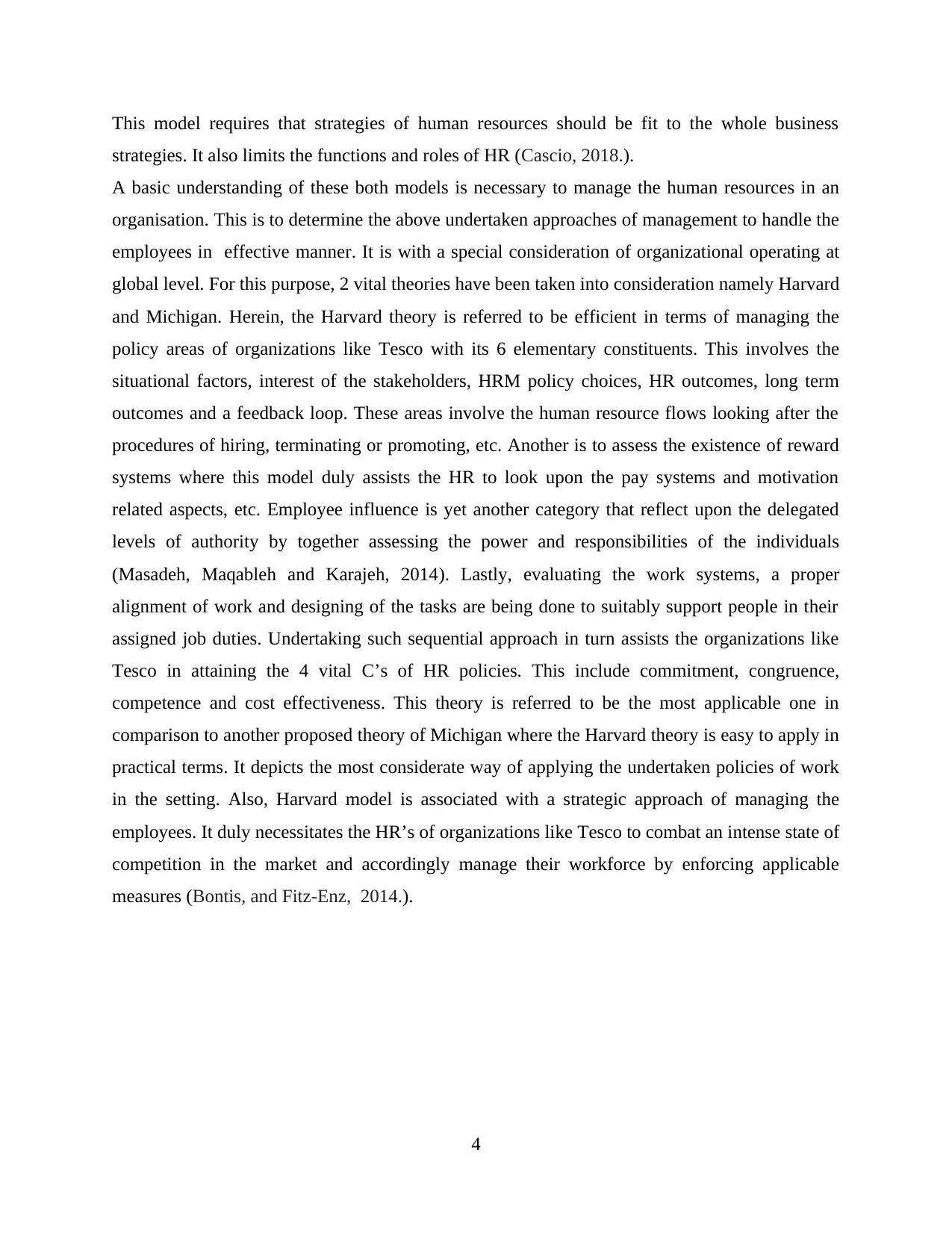
This model requires that strategies of human resources should be fit to the whole business
strategies. It also limits the functions and roles of HR (Cascio, 2018.).
A basic understanding of these both models is necessary to manage the human resources in an
organisation. This is to determine the above undertaken approaches of management to handle the
employees in effective manner. It is with a special consideration of organizational operating at
global level. For this purpose, 2 vital theories have been taken into consideration namely Harvard
and Michigan. Herein, the Harvard theory is referred to be efficient in terms of managing the
policy areas of organizations like Tesco with its 6 elementary constituents. This involves the
situational factors, interest of the stakeholders, HRM policy choices, HR outcomes, long term
outcomes and a feedback loop. These areas involve the human resource flows looking after the
procedures of hiring, terminating or promoting, etc. Another is to assess the existence of reward
systems where this model duly assists the HR to look upon the pay systems and motivation
related aspects, etc. Employee influence is yet another category that reflect upon the delegated
levels of authority by together assessing the power and responsibilities of the individuals
(Masadeh, Maqableh and Karajeh, 2014). Lastly, evaluating the work systems, a proper
alignment of work and designing of the tasks are being done to suitably support people in their
assigned job duties. Undertaking such sequential approach in turn assists the organizations like
Tesco in attaining the 4 vital C’s of HR policies. This include commitment, congruence,
competence and cost effectiveness. This theory is referred to be the most applicable one in
comparison to another proposed theory of Michigan where the Harvard theory is easy to apply in
practical terms. It depicts the most considerate way of applying the undertaken policies of work
in the setting. Also, Harvard model is associated with a strategic approach of managing the
employees. It duly necessitates the HR’s of organizations like Tesco to combat an intense state of
competition in the market and accordingly manage their workforce by enforcing applicable
measures (Bontis, and Fitz-Enz, 2014.).
4
strategies. It also limits the functions and roles of HR (Cascio, 2018.).
A basic understanding of these both models is necessary to manage the human resources in an
organisation. This is to determine the above undertaken approaches of management to handle the
employees in effective manner. It is with a special consideration of organizational operating at
global level. For this purpose, 2 vital theories have been taken into consideration namely Harvard
and Michigan. Herein, the Harvard theory is referred to be efficient in terms of managing the
policy areas of organizations like Tesco with its 6 elementary constituents. This involves the
situational factors, interest of the stakeholders, HRM policy choices, HR outcomes, long term
outcomes and a feedback loop. These areas involve the human resource flows looking after the
procedures of hiring, terminating or promoting, etc. Another is to assess the existence of reward
systems where this model duly assists the HR to look upon the pay systems and motivation
related aspects, etc. Employee influence is yet another category that reflect upon the delegated
levels of authority by together assessing the power and responsibilities of the individuals
(Masadeh, Maqableh and Karajeh, 2014). Lastly, evaluating the work systems, a proper
alignment of work and designing of the tasks are being done to suitably support people in their
assigned job duties. Undertaking such sequential approach in turn assists the organizations like
Tesco in attaining the 4 vital C’s of HR policies. This include commitment, congruence,
competence and cost effectiveness. This theory is referred to be the most applicable one in
comparison to another proposed theory of Michigan where the Harvard theory is easy to apply in
practical terms. It depicts the most considerate way of applying the undertaken policies of work
in the setting. Also, Harvard model is associated with a strategic approach of managing the
employees. It duly necessitates the HR’s of organizations like Tesco to combat an intense state of
competition in the market and accordingly manage their workforce by enforcing applicable
measures (Bontis, and Fitz-Enz, 2014.).
4
Paraphrase This Document
Need a fresh take? Get an instant paraphrase of this document with our AI Paraphraser
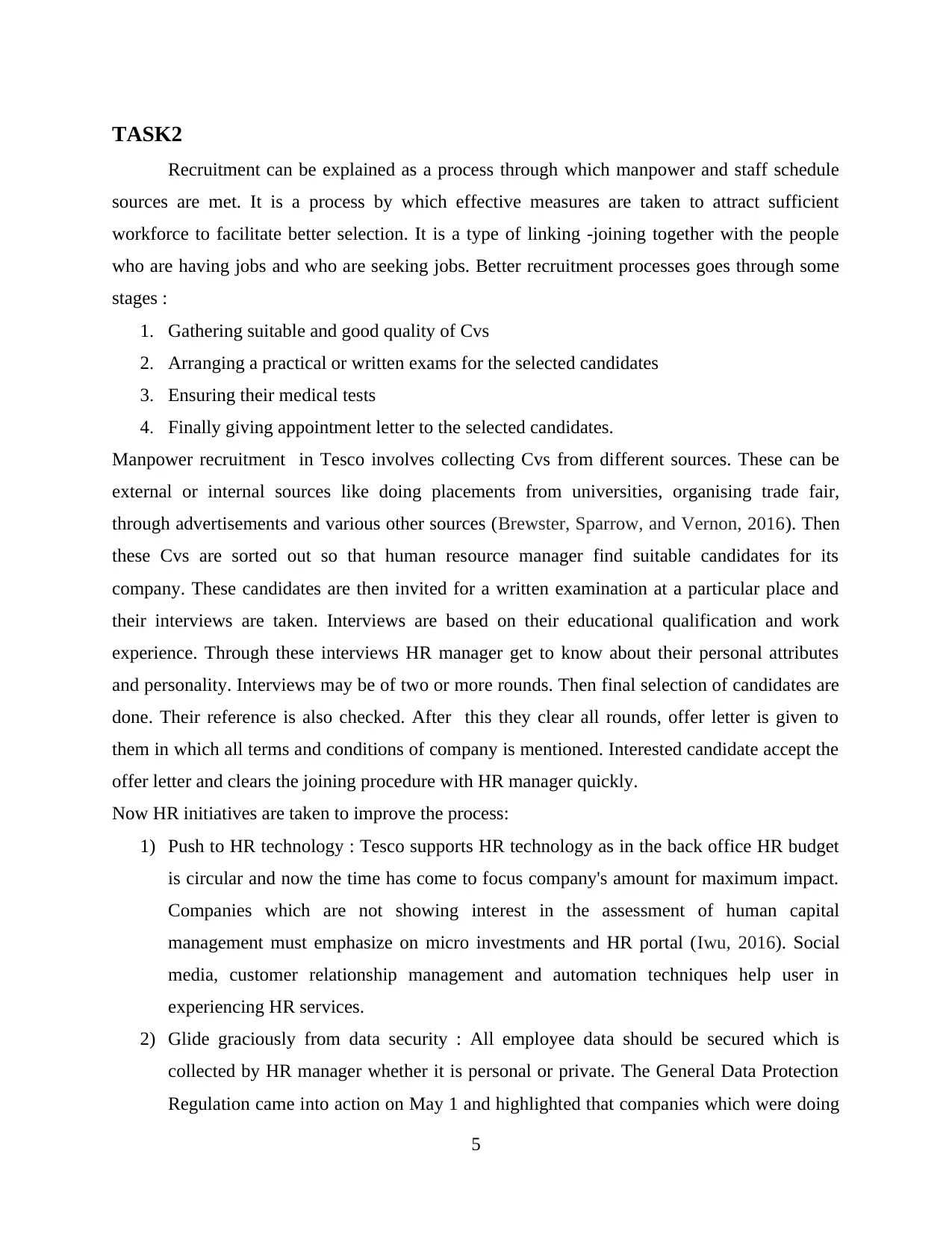
TASK2
Recruitment can be explained as a process through which manpower and staff schedule
sources are met. It is a process by which effective measures are taken to attract sufficient
workforce to facilitate better selection. It is a type of linking -joining together with the people
who are having jobs and who are seeking jobs. Better recruitment processes goes through some
stages :
1. Gathering suitable and good quality of Cvs
2. Arranging a practical or written exams for the selected candidates
3. Ensuring their medical tests
4. Finally giving appointment letter to the selected candidates.
Manpower recruitment in Tesco involves collecting Cvs from different sources. These can be
external or internal sources like doing placements from universities, organising trade fair,
through advertisements and various other sources (Brewster, Sparrow, and Vernon, 2016). Then
these Cvs are sorted out so that human resource manager find suitable candidates for its
company. These candidates are then invited for a written examination at a particular place and
their interviews are taken. Interviews are based on their educational qualification and work
experience. Through these interviews HR manager get to know about their personal attributes
and personality. Interviews may be of two or more rounds. Then final selection of candidates are
done. Their reference is also checked. After this they clear all rounds, offer letter is given to
them in which all terms and conditions of company is mentioned. Interested candidate accept the
offer letter and clears the joining procedure with HR manager quickly.
Now HR initiatives are taken to improve the process:
1) Push to HR technology : Tesco supports HR technology as in the back office HR budget
is circular and now the time has come to focus company's amount for maximum impact.
Companies which are not showing interest in the assessment of human capital
management must emphasize on micro investments and HR portal (Iwu, 2016). Social
media, customer relationship management and automation techniques help user in
experiencing HR services.
2) Glide graciously from data security : All employee data should be secured which is
collected by HR manager whether it is personal or private. The General Data Protection
Regulation came into action on May 1 and highlighted that companies which were doing
5
Recruitment can be explained as a process through which manpower and staff schedule
sources are met. It is a process by which effective measures are taken to attract sufficient
workforce to facilitate better selection. It is a type of linking -joining together with the people
who are having jobs and who are seeking jobs. Better recruitment processes goes through some
stages :
1. Gathering suitable and good quality of Cvs
2. Arranging a practical or written exams for the selected candidates
3. Ensuring their medical tests
4. Finally giving appointment letter to the selected candidates.
Manpower recruitment in Tesco involves collecting Cvs from different sources. These can be
external or internal sources like doing placements from universities, organising trade fair,
through advertisements and various other sources (Brewster, Sparrow, and Vernon, 2016). Then
these Cvs are sorted out so that human resource manager find suitable candidates for its
company. These candidates are then invited for a written examination at a particular place and
their interviews are taken. Interviews are based on their educational qualification and work
experience. Through these interviews HR manager get to know about their personal attributes
and personality. Interviews may be of two or more rounds. Then final selection of candidates are
done. Their reference is also checked. After this they clear all rounds, offer letter is given to
them in which all terms and conditions of company is mentioned. Interested candidate accept the
offer letter and clears the joining procedure with HR manager quickly.
Now HR initiatives are taken to improve the process:
1) Push to HR technology : Tesco supports HR technology as in the back office HR budget
is circular and now the time has come to focus company's amount for maximum impact.
Companies which are not showing interest in the assessment of human capital
management must emphasize on micro investments and HR portal (Iwu, 2016). Social
media, customer relationship management and automation techniques help user in
experiencing HR services.
2) Glide graciously from data security : All employee data should be secured which is
collected by HR manager whether it is personal or private. The General Data Protection
Regulation came into action on May 1 and highlighted that companies which were doing
5
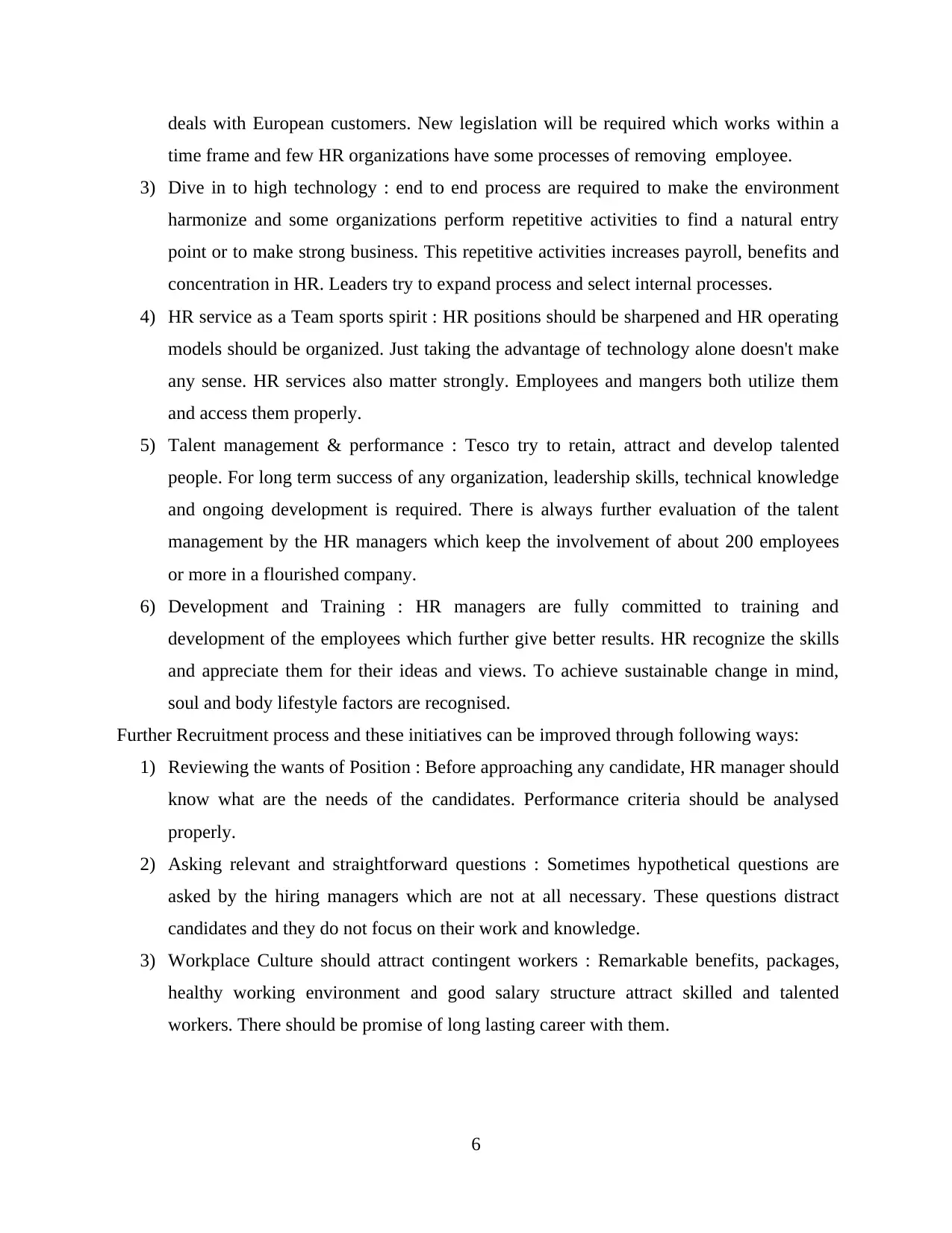
deals with European customers. New legislation will be required which works within a
time frame and few HR organizations have some processes of removing employee.
3) Dive in to high technology : end to end process are required to make the environment
harmonize and some organizations perform repetitive activities to find a natural entry
point or to make strong business. This repetitive activities increases payroll, benefits and
concentration in HR. Leaders try to expand process and select internal processes.
4) HR service as a Team sports spirit : HR positions should be sharpened and HR operating
models should be organized. Just taking the advantage of technology alone doesn't make
any sense. HR services also matter strongly. Employees and mangers both utilize them
and access them properly.
5) Talent management & performance : Tesco try to retain, attract and develop talented
people. For long term success of any organization, leadership skills, technical knowledge
and ongoing development is required. There is always further evaluation of the talent
management by the HR managers which keep the involvement of about 200 employees
or more in a flourished company.
6) Development and Training : HR managers are fully committed to training and
development of the employees which further give better results. HR recognize the skills
and appreciate them for their ideas and views. To achieve sustainable change in mind,
soul and body lifestyle factors are recognised.
Further Recruitment process and these initiatives can be improved through following ways:
1) Reviewing the wants of Position : Before approaching any candidate, HR manager should
know what are the needs of the candidates. Performance criteria should be analysed
properly.
2) Asking relevant and straightforward questions : Sometimes hypothetical questions are
asked by the hiring managers which are not at all necessary. These questions distract
candidates and they do not focus on their work and knowledge.
3) Workplace Culture should attract contingent workers : Remarkable benefits, packages,
healthy working environment and good salary structure attract skilled and talented
workers. There should be promise of long lasting career with them.
6
time frame and few HR organizations have some processes of removing employee.
3) Dive in to high technology : end to end process are required to make the environment
harmonize and some organizations perform repetitive activities to find a natural entry
point or to make strong business. This repetitive activities increases payroll, benefits and
concentration in HR. Leaders try to expand process and select internal processes.
4) HR service as a Team sports spirit : HR positions should be sharpened and HR operating
models should be organized. Just taking the advantage of technology alone doesn't make
any sense. HR services also matter strongly. Employees and mangers both utilize them
and access them properly.
5) Talent management & performance : Tesco try to retain, attract and develop talented
people. For long term success of any organization, leadership skills, technical knowledge
and ongoing development is required. There is always further evaluation of the talent
management by the HR managers which keep the involvement of about 200 employees
or more in a flourished company.
6) Development and Training : HR managers are fully committed to training and
development of the employees which further give better results. HR recognize the skills
and appreciate them for their ideas and views. To achieve sustainable change in mind,
soul and body lifestyle factors are recognised.
Further Recruitment process and these initiatives can be improved through following ways:
1) Reviewing the wants of Position : Before approaching any candidate, HR manager should
know what are the needs of the candidates. Performance criteria should be analysed
properly.
2) Asking relevant and straightforward questions : Sometimes hypothetical questions are
asked by the hiring managers which are not at all necessary. These questions distract
candidates and they do not focus on their work and knowledge.
3) Workplace Culture should attract contingent workers : Remarkable benefits, packages,
healthy working environment and good salary structure attract skilled and talented
workers. There should be promise of long lasting career with them.
6
⊘ This is a preview!⊘
Do you want full access?
Subscribe today to unlock all pages.

Trusted by 1+ million students worldwide
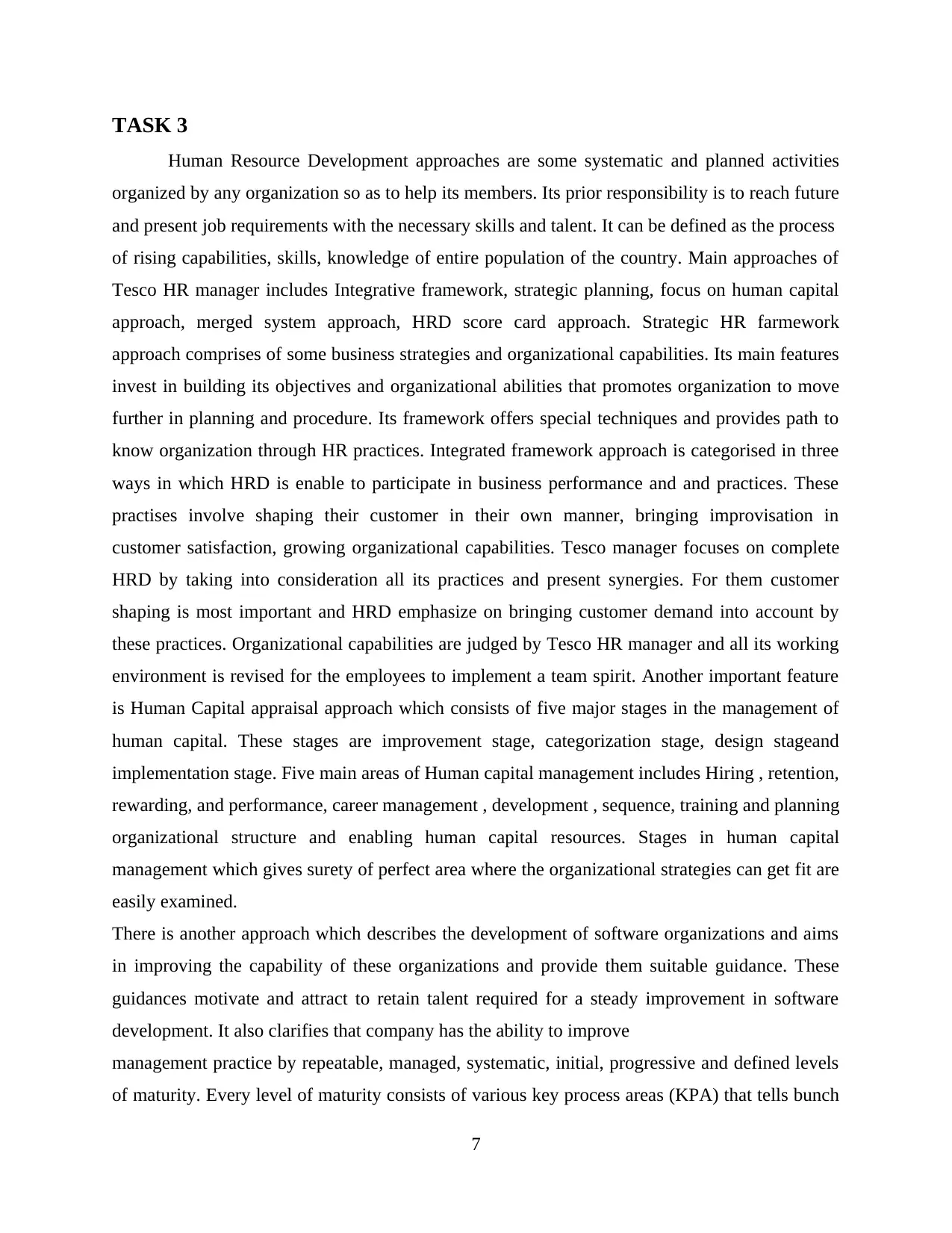
TASK 3
Human Resource Development approaches are some systematic and planned activities
organized by any organization so as to help its members. Its prior responsibility is to reach future
and present job requirements with the necessary skills and talent. It can be defined as the process
of rising capabilities, skills, knowledge of entire population of the country. Main approaches of
Tesco HR manager includes Integrative framework, strategic planning, focus on human capital
approach, merged system approach, HRD score card approach. Strategic HR farmework
approach comprises of some business strategies and organizational capabilities. Its main features
invest in building its objectives and organizational abilities that promotes organization to move
further in planning and procedure. Its framework offers special techniques and provides path to
know organization through HR practices. Integrated framework approach is categorised in three
ways in which HRD is enable to participate in business performance and and practices. These
practises involve shaping their customer in their own manner, bringing improvisation in
customer satisfaction, growing organizational capabilities. Tesco manager focuses on complete
HRD by taking into consideration all its practices and present synergies. For them customer
shaping is most important and HRD emphasize on bringing customer demand into account by
these practices. Organizational capabilities are judged by Tesco HR manager and all its working
environment is revised for the employees to implement a team spirit. Another important feature
is Human Capital appraisal approach which consists of five major stages in the management of
human capital. These stages are improvement stage, categorization stage, design stageand
implementation stage. Five main areas of Human capital management includes Hiring , retention,
rewarding, and performance, career management , development , sequence, training and planning
organizational structure and enabling human capital resources. Stages in human capital
management which gives surety of perfect area where the organizational strategies can get fit are
easily examined.
There is another approach which describes the development of software organizations and aims
in improving the capability of these organizations and provide them suitable guidance. These
guidances motivate and attract to retain talent required for a steady improvement in software
development. It also clarifies that company has the ability to improve
management practice by repeatable, managed, systematic, initial, progressive and defined levels
of maturity. Every level of maturity consists of various key process areas (KPA) that tells bunch
7
Human Resource Development approaches are some systematic and planned activities
organized by any organization so as to help its members. Its prior responsibility is to reach future
and present job requirements with the necessary skills and talent. It can be defined as the process
of rising capabilities, skills, knowledge of entire population of the country. Main approaches of
Tesco HR manager includes Integrative framework, strategic planning, focus on human capital
approach, merged system approach, HRD score card approach. Strategic HR farmework
approach comprises of some business strategies and organizational capabilities. Its main features
invest in building its objectives and organizational abilities that promotes organization to move
further in planning and procedure. Its framework offers special techniques and provides path to
know organization through HR practices. Integrated framework approach is categorised in three
ways in which HRD is enable to participate in business performance and and practices. These
practises involve shaping their customer in their own manner, bringing improvisation in
customer satisfaction, growing organizational capabilities. Tesco manager focuses on complete
HRD by taking into consideration all its practices and present synergies. For them customer
shaping is most important and HRD emphasize on bringing customer demand into account by
these practices. Organizational capabilities are judged by Tesco HR manager and all its working
environment is revised for the employees to implement a team spirit. Another important feature
is Human Capital appraisal approach which consists of five major stages in the management of
human capital. These stages are improvement stage, categorization stage, design stageand
implementation stage. Five main areas of Human capital management includes Hiring , retention,
rewarding, and performance, career management , development , sequence, training and planning
organizational structure and enabling human capital resources. Stages in human capital
management which gives surety of perfect area where the organizational strategies can get fit are
easily examined.
There is another approach which describes the development of software organizations and aims
in improving the capability of these organizations and provide them suitable guidance. These
guidances motivate and attract to retain talent required for a steady improvement in software
development. It also clarifies that company has the ability to improve
management practice by repeatable, managed, systematic, initial, progressive and defined levels
of maturity. Every level of maturity consists of various key process areas (KPA) that tells bunch
7
Paraphrase This Document
Need a fresh take? Get an instant paraphrase of this document with our AI Paraphraser
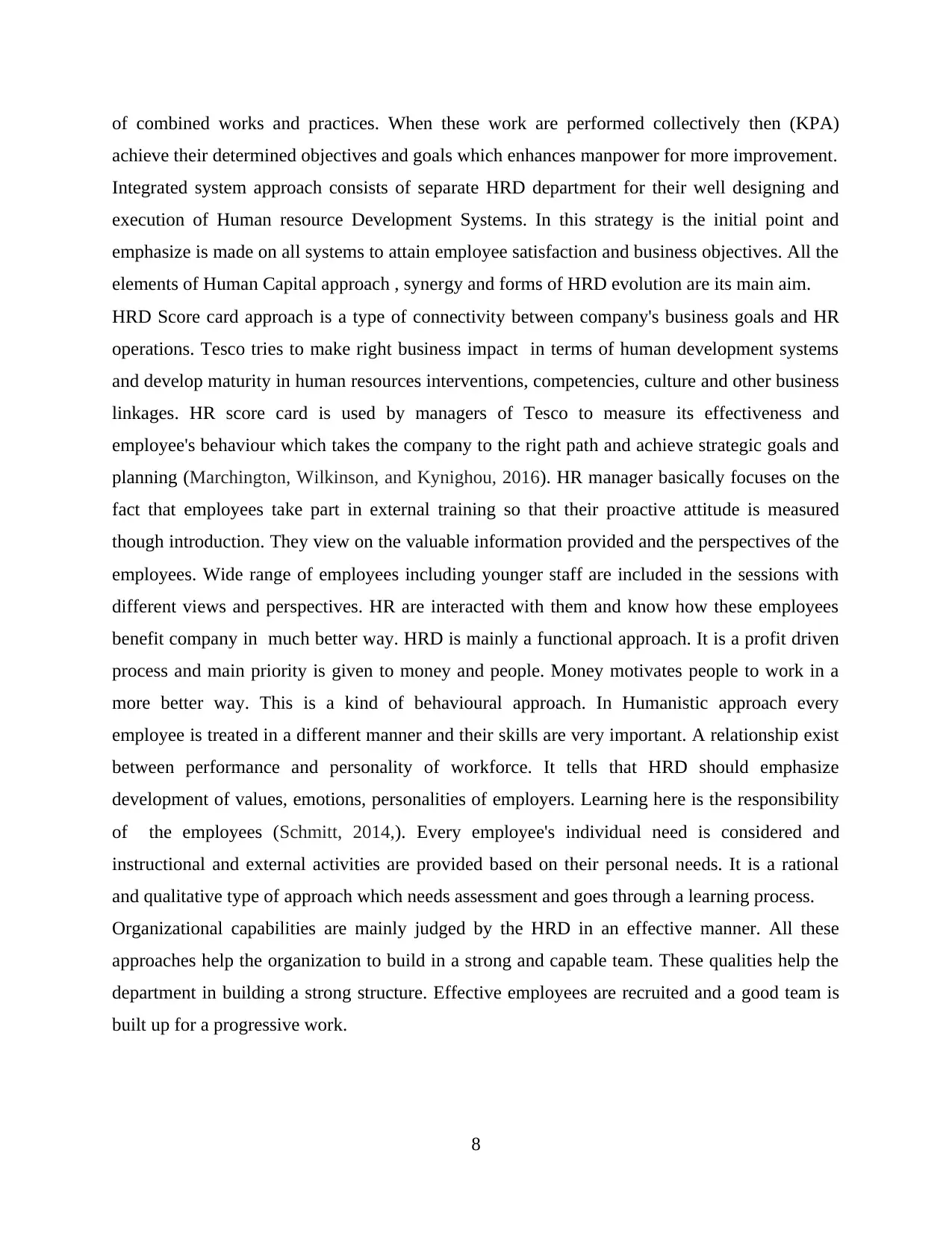
of combined works and practices. When these work are performed collectively then (KPA)
achieve their determined objectives and goals which enhances manpower for more improvement.
Integrated system approach consists of separate HRD department for their well designing and
execution of Human resource Development Systems. In this strategy is the initial point and
emphasize is made on all systems to attain employee satisfaction and business objectives. All the
elements of Human Capital approach , synergy and forms of HRD evolution are its main aim.
HRD Score card approach is a type of connectivity between company's business goals and HR
operations. Tesco tries to make right business impact in terms of human development systems
and develop maturity in human resources interventions, competencies, culture and other business
linkages. HR score card is used by managers of Tesco to measure its effectiveness and
employee's behaviour which takes the company to the right path and achieve strategic goals and
planning (Marchington, Wilkinson, and Kynighou, 2016). HR manager basically focuses on the
fact that employees take part in external training so that their proactive attitude is measured
though introduction. They view on the valuable information provided and the perspectives of the
employees. Wide range of employees including younger staff are included in the sessions with
different views and perspectives. HR are interacted with them and know how these employees
benefit company in much better way. HRD is mainly a functional approach. It is a profit driven
process and main priority is given to money and people. Money motivates people to work in a
more better way. This is a kind of behavioural approach. In Humanistic approach every
employee is treated in a different manner and their skills are very important. A relationship exist
between performance and personality of workforce. It tells that HRD should emphasize
development of values, emotions, personalities of employers. Learning here is the responsibility
of the employees (Schmitt, 2014,). Every employee's individual need is considered and
instructional and external activities are provided based on their personal needs. It is a rational
and qualitative type of approach which needs assessment and goes through a learning process.
Organizational capabilities are mainly judged by the HRD in an effective manner. All these
approaches help the organization to build in a strong and capable team. These qualities help the
department in building a strong structure. Effective employees are recruited and a good team is
built up for a progressive work.
8
achieve their determined objectives and goals which enhances manpower for more improvement.
Integrated system approach consists of separate HRD department for their well designing and
execution of Human resource Development Systems. In this strategy is the initial point and
emphasize is made on all systems to attain employee satisfaction and business objectives. All the
elements of Human Capital approach , synergy and forms of HRD evolution are its main aim.
HRD Score card approach is a type of connectivity between company's business goals and HR
operations. Tesco tries to make right business impact in terms of human development systems
and develop maturity in human resources interventions, competencies, culture and other business
linkages. HR score card is used by managers of Tesco to measure its effectiveness and
employee's behaviour which takes the company to the right path and achieve strategic goals and
planning (Marchington, Wilkinson, and Kynighou, 2016). HR manager basically focuses on the
fact that employees take part in external training so that their proactive attitude is measured
though introduction. They view on the valuable information provided and the perspectives of the
employees. Wide range of employees including younger staff are included in the sessions with
different views and perspectives. HR are interacted with them and know how these employees
benefit company in much better way. HRD is mainly a functional approach. It is a profit driven
process and main priority is given to money and people. Money motivates people to work in a
more better way. This is a kind of behavioural approach. In Humanistic approach every
employee is treated in a different manner and their skills are very important. A relationship exist
between performance and personality of workforce. It tells that HRD should emphasize
development of values, emotions, personalities of employers. Learning here is the responsibility
of the employees (Schmitt, 2014,). Every employee's individual need is considered and
instructional and external activities are provided based on their personal needs. It is a rational
and qualitative type of approach which needs assessment and goes through a learning process.
Organizational capabilities are mainly judged by the HRD in an effective manner. All these
approaches help the organization to build in a strong and capable team. These qualities help the
department in building a strong structure. Effective employees are recruited and a good team is
built up for a progressive work.
8
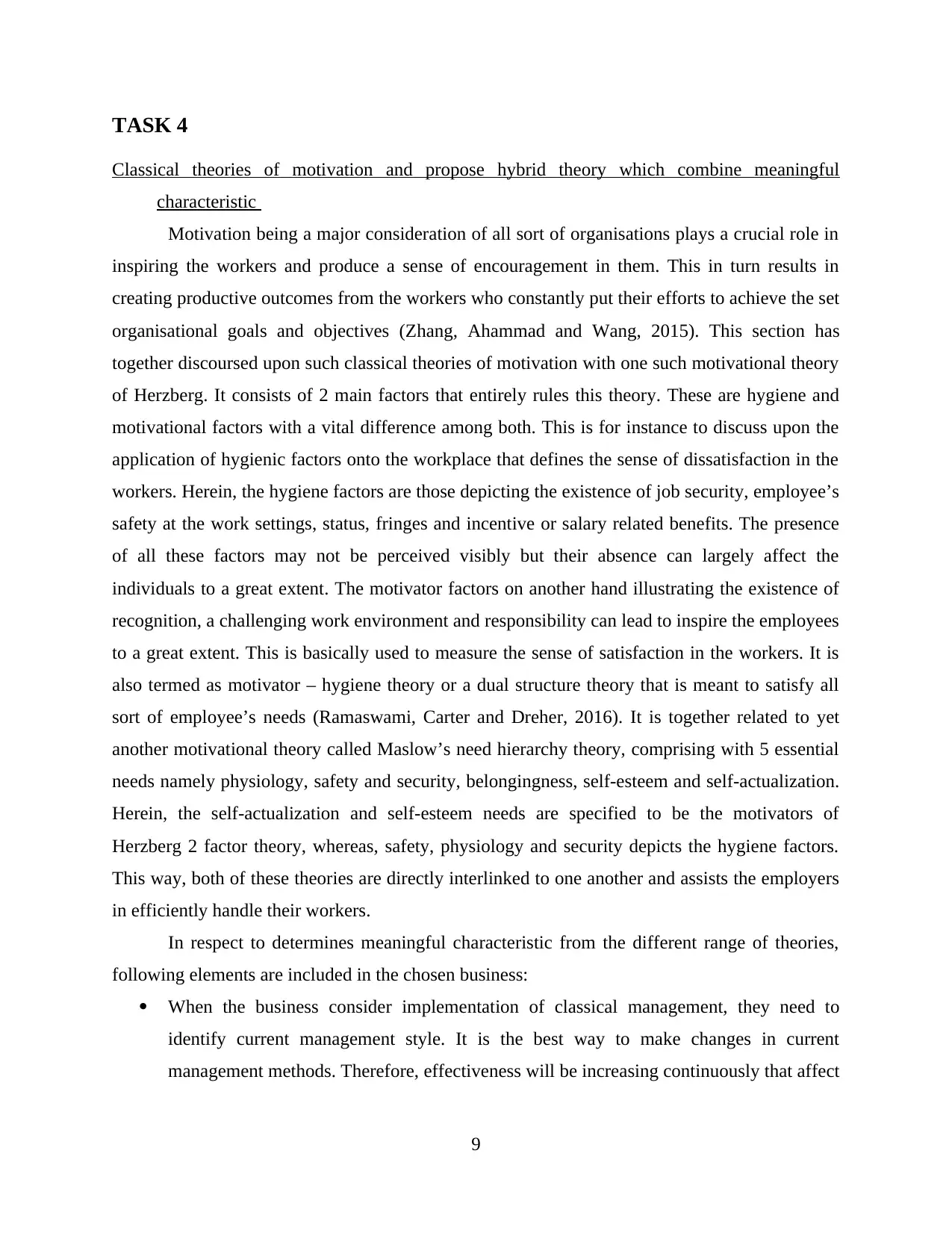
TASK 4
Classical theories of motivation and propose hybrid theory which combine meaningful
characteristic
Motivation being a major consideration of all sort of organisations plays a crucial role in
inspiring the workers and produce a sense of encouragement in them. This in turn results in
creating productive outcomes from the workers who constantly put their efforts to achieve the set
organisational goals and objectives (Zhang, Ahammad and Wang, 2015). This section has
together discoursed upon such classical theories of motivation with one such motivational theory
of Herzberg. It consists of 2 main factors that entirely rules this theory. These are hygiene and
motivational factors with a vital difference among both. This is for instance to discuss upon the
application of hygienic factors onto the workplace that defines the sense of dissatisfaction in the
workers. Herein, the hygiene factors are those depicting the existence of job security, employee’s
safety at the work settings, status, fringes and incentive or salary related benefits. The presence
of all these factors may not be perceived visibly but their absence can largely affect the
individuals to a great extent. The motivator factors on another hand illustrating the existence of
recognition, a challenging work environment and responsibility can lead to inspire the employees
to a great extent. This is basically used to measure the sense of satisfaction in the workers. It is
also termed as motivator – hygiene theory or a dual structure theory that is meant to satisfy all
sort of employee’s needs (Ramaswami, Carter and Dreher, 2016). It is together related to yet
another motivational theory called Maslow’s need hierarchy theory, comprising with 5 essential
needs namely physiology, safety and security, belongingness, self-esteem and self-actualization.
Herein, the self-actualization and self-esteem needs are specified to be the motivators of
Herzberg 2 factor theory, whereas, safety, physiology and security depicts the hygiene factors.
This way, both of these theories are directly interlinked to one another and assists the employers
in efficiently handle their workers.
In respect to determines meaningful characteristic from the different range of theories,
following elements are included in the chosen business:
When the business consider implementation of classical management, they need to
identify current management style. It is the best way to make changes in current
management methods. Therefore, effectiveness will be increasing continuously that affect
9
Classical theories of motivation and propose hybrid theory which combine meaningful
characteristic
Motivation being a major consideration of all sort of organisations plays a crucial role in
inspiring the workers and produce a sense of encouragement in them. This in turn results in
creating productive outcomes from the workers who constantly put their efforts to achieve the set
organisational goals and objectives (Zhang, Ahammad and Wang, 2015). This section has
together discoursed upon such classical theories of motivation with one such motivational theory
of Herzberg. It consists of 2 main factors that entirely rules this theory. These are hygiene and
motivational factors with a vital difference among both. This is for instance to discuss upon the
application of hygienic factors onto the workplace that defines the sense of dissatisfaction in the
workers. Herein, the hygiene factors are those depicting the existence of job security, employee’s
safety at the work settings, status, fringes and incentive or salary related benefits. The presence
of all these factors may not be perceived visibly but their absence can largely affect the
individuals to a great extent. The motivator factors on another hand illustrating the existence of
recognition, a challenging work environment and responsibility can lead to inspire the employees
to a great extent. This is basically used to measure the sense of satisfaction in the workers. It is
also termed as motivator – hygiene theory or a dual structure theory that is meant to satisfy all
sort of employee’s needs (Ramaswami, Carter and Dreher, 2016). It is together related to yet
another motivational theory called Maslow’s need hierarchy theory, comprising with 5 essential
needs namely physiology, safety and security, belongingness, self-esteem and self-actualization.
Herein, the self-actualization and self-esteem needs are specified to be the motivators of
Herzberg 2 factor theory, whereas, safety, physiology and security depicts the hygiene factors.
This way, both of these theories are directly interlinked to one another and assists the employers
in efficiently handle their workers.
In respect to determines meaningful characteristic from the different range of theories,
following elements are included in the chosen business:
When the business consider implementation of classical management, they need to
identify current management style. It is the best way to make changes in current
management methods. Therefore, effectiveness will be increasing continuously that affect
9
⊘ This is a preview!⊘
Do you want full access?
Subscribe today to unlock all pages.

Trusted by 1+ million students worldwide
1 out of 18
Related Documents
Your All-in-One AI-Powered Toolkit for Academic Success.
+13062052269
info@desklib.com
Available 24*7 on WhatsApp / Email
![[object Object]](/_next/static/media/star-bottom.7253800d.svg)
Unlock your academic potential
Copyright © 2020–2025 A2Z Services. All Rights Reserved. Developed and managed by ZUCOL.





